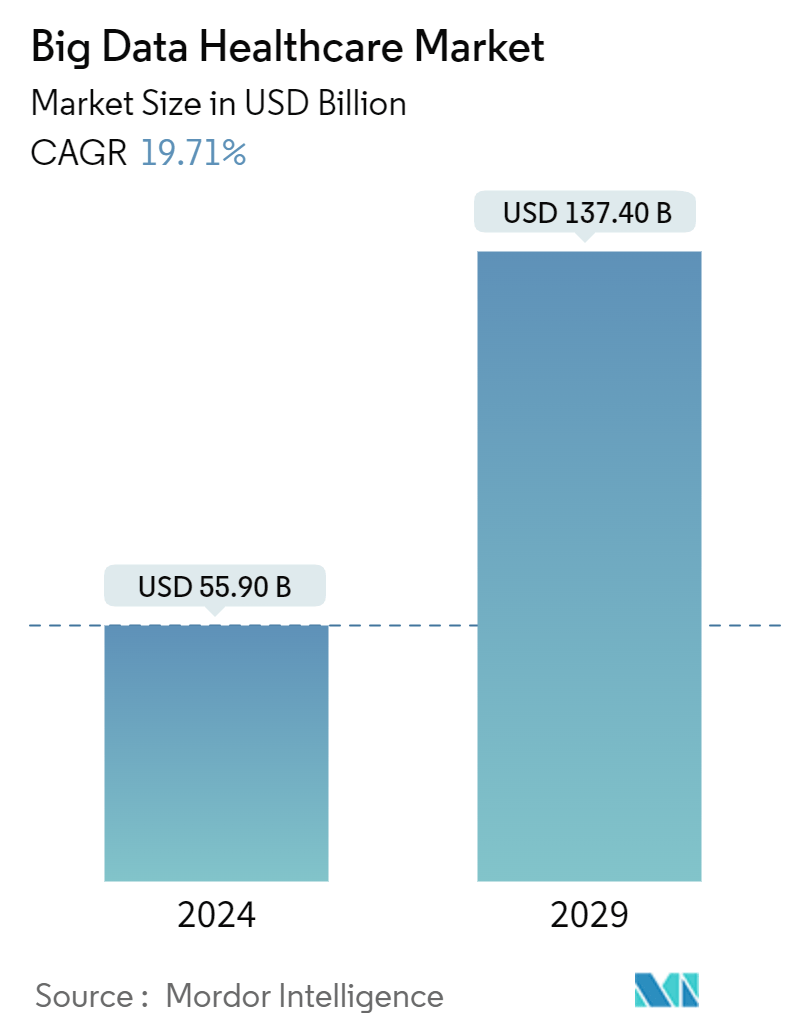Market Size of Big Data Healthcare Industry

| Study Period | 2019 - 2029 |
| Market Size (2024) | USD 55.90 Billion |
| Market Size (2029) | USD 137.40 Billion |
| CAGR (2024 - 2029) | 19.71 % |
| Fastest Growing Market | Asia Pacific |
| Largest Market | North America |
| Market Concentration | Medium |
Major Players
*Disclaimer: Major Players sorted in no particular order |
Big Data in Healthcare Market Analysis
The Big Data Healthcare Market size is estimated at USD 55.90 billion in 2024, and is expected to reach USD 137.40 billion by 2029, growing at a CAGR of 19.71% during the forecast period (2024-2029).
The impact of COVID-19 was significant on the studied market as it led to the critical need for cutting-edge technological tools and innovation in the areas of public health, medicine, and wellness, which boosted the utility of big data healthcare solutions. Several companies were engaged in utilizing big data for analyzing patient data and outcomes to better understand the diagnosis and treatment prospects. For instance, in June 2020, the United Kingdom government collaborated with Palantir, a United States-based big data firm, to investigate patient data to respond further to the COVID-19 pandemic. Hence, such initiatives boosted the demand for big data in the healthcare sector during the pandemic and significantly impacted the market.
The need for the deployment of big data in the healthcare sector for disease trend and analysis prediction in recent years has resulted from the healthcare challenges faced during the pandemic with regard to the analysis of enormous data amounts and predict the spread of the coronavirus. The market has been stabilizing in the recent year as the digital transformation of healthcare settings is on the rise, thereby estimated to propel the market growth during the forecast period.
In addition, the increase in demand for analytics solutions for population health management, the rise in the need for business intelligence to optimize health administration and strategy, and the surge in the adoption of big data in the healthcare industry are the factors that drive the growth of the market.
According to a research article published in Nature Public Health Emergency Collection Journal in January 2022, which conducted a survey of 217 medical facilities in Poland reported, the use of big data analytics can aid medical facilities in various ways. The direct research reported that medical facilities in Poland are moving towards data-based healthcare in the current year as they use structured and unstructured data, reach for analytics in the administrative, business, and clinical area, and the adoption of big data in the medical facilities.
Big data analytics in healthcare is the complex process of examining big data to discover information, including hidden patterns, market trends, unknown correlations, and customer preferences. This helps organizations make informed clinical and business decisions. The increase in demand for big data solutions for population health management and the rise in the need for business intelligence to optimize health administration and strategy are expected to drive market growth.
Furthermore, various market players are engaged in strategic initiatives such as product launches, partnerships, and research and development investment, fueling market growth. For instance, in July 2022, Healthcare Triangle Inc, a provider of healthcare and life sciences cloud transformation, managed services, and data analytics platforms, launched its software in Singapore to boost digital healthcare in the city, state, and across the Asia Pacific region. The company announced investing USD 25 million in Singapore over the next five years.
Therefore, owing to the aforementioned factors, the studied market is anticipated to witness growth over the analysis period. However, security concerns related to sensitive patient medical data and the high cost of implementation and deployment are likely to impede the market growth.
Big Data in Healthcare Industry Segmentation
As per the scope of the report, big data in healthcare refers to examining big data to discover health information. The data is amassed from numerous sources, including Electronic Health Records (EHRs), medical imaging, genomic sequencing, pharmaceutical research, wearables, and medical devices. The Big Data Healthcare market is segmented by Component (Software and Services), Deployment (On-premise and Cloud-based), application (Financial Analytics, Clinical Data Analytics, Operational Analytics, and Population Health Analytics), and geography (North America, Europe, Asia-Pacific, Middle East, and Africa, and South America). The market report also covers the estimated market sizes and trends for 17 different countries across major regions globally. The report offers the value (in USD million) for the above segments.
| By Component | |
| Software | |
| Services |
| By Deployment | |
| On-premise | |
| Cloud |
| By Application | |
| Financial Analytics | |
| Clinical Data Analytics | |
| Operational Analytics | |
| Population Health Analytics |
| Geography | ||||||||
| ||||||||
| ||||||||
| ||||||||
| ||||||||
|
Big Data Healthcare Market Size Summary
The big data healthcare market is poised for substantial growth, driven by the increasing need for advanced technological solutions in public health, medicine, and wellness. The COVID-19 pandemic underscored the critical importance of big data analytics in understanding disease trends and improving patient outcomes, leading to heightened demand for these solutions. The market is experiencing a digital transformation, with a growing emphasis on analytics for population health management and business intelligence to optimize healthcare administration. Strategic initiatives by key players, such as product launches and investments in research and development, are further propelling market expansion. However, challenges such as security concerns related to sensitive patient data and high implementation costs may impede growth.
North America is expected to dominate the big data healthcare market, supported by advancements in the Internet of Things (IoT) and a robust healthcare infrastructure that facilitates the adoption of electronic health records (EHRs) and telemedicine. The region's well-established healthcare system and government policies promoting digital healthcare solutions are key factors driving market growth. Collaborative strategies and investments in health IT are also contributing to the market's expansion. The competitive landscape is characterized by a few major players, both globally and regionally, who are actively engaged in strategic partnerships and technological advancements to enhance their market position.
Big Data Healthcare Market Size - Table of Contents
-
1. MARKET DYNAMICS
-
1.1 Market Overview
-
1.2 Market Drivers
-
1.2.1 Increase in Demand for Analytics Solutions for Population Health Management
-
1.2.2 Rise in Need for Business Intelligence to Optimize Health Administration and Strategy
-
1.2.3 Surge in Adoption of Big Data in the Healthcare Industry
-
-
1.3 Market Restraints
-
1.3.1 Security Concerns Related to Sensitive Patients Medical Data
-
1.3.2 High Cost of Implementation and Deployment
-
-
1.4 Porter Five Forces
-
1.4.1 Threat of New Entrants
-
1.4.2 Bargaining Power of Buyers/Consumers
-
1.4.3 Bargaining Power of Suppliers
-
1.4.4 Threat of Substitute Products
-
1.4.5 Intensity of Competitive Rivalry
-
-
-
2. MARKET SEGMENTATION (Market Size by Value - USD million)
-
2.1 By Component
-
2.1.1 Software
-
2.1.2 Services
-
-
2.2 By Deployment
-
2.2.1 On-premise
-
2.2.2 Cloud
-
-
2.3 By Application
-
2.3.1 Financial Analytics
-
2.3.2 Clinical Data Analytics
-
2.3.3 Operational Analytics
-
2.3.4 Population Health Analytics
-
-
2.4 Geography
-
2.4.1 North America
-
2.4.1.1 United States
-
2.4.1.2 Canada
-
2.4.1.3 Mexico
-
-
2.4.2 Europe
-
2.4.2.1 Germany
-
2.4.2.2 United Kingdom
-
2.4.2.3 France
-
2.4.2.4 Italy
-
2.4.2.5 Spain
-
2.4.2.6 Rest of Europe
-
-
2.4.3 Asia-Pacific
-
2.4.3.1 China
-
2.4.3.2 Japan
-
2.4.3.3 India
-
2.4.3.4 Australia
-
2.4.3.5 South Korea
-
2.4.3.6 Rest of Asia-Pacific
-
-
2.4.4 Middle East and Africa
-
2.4.4.1 GCC
-
2.4.4.2 South Africa
-
2.4.4.3 Rest of Middle East and Africa
-
-
2.4.5 South America
-
2.4.5.1 Brazil
-
2.4.5.2 Argentina
-
2.4.5.3 Rest of South America
-
-
-
Big Data Healthcare Market Size FAQs
How big is the Big Data Healthcare Market?
The Big Data Healthcare Market size is expected to reach USD 55.90 billion in 2024 and grow at a CAGR of 19.71% to reach USD 137.40 billion by 2029.
What is the current Big Data Healthcare Market size?
In 2024, the Big Data Healthcare Market size is expected to reach USD 55.90 billion.

